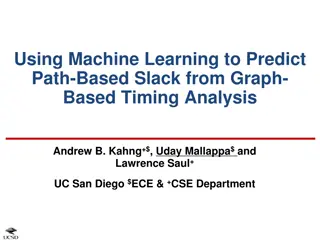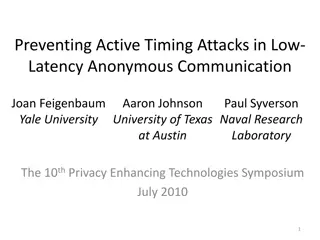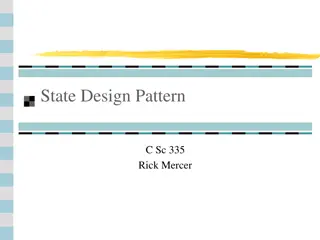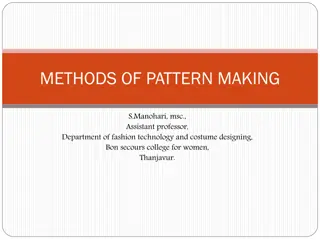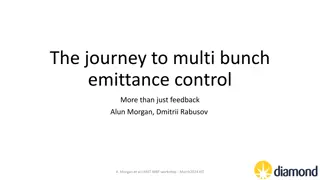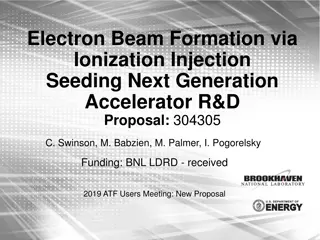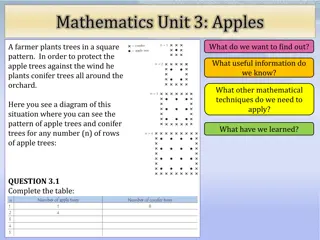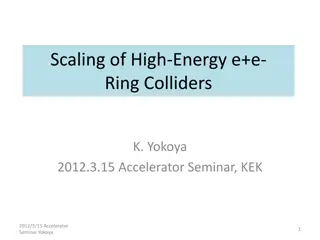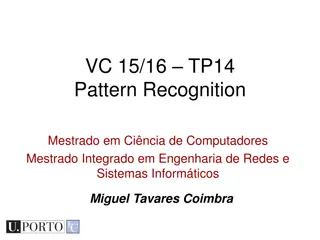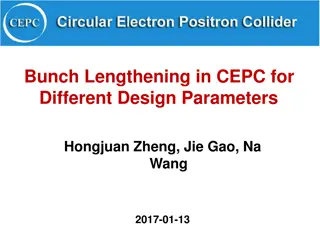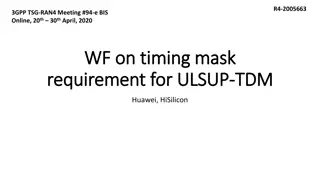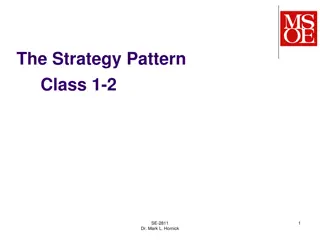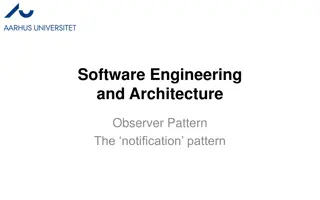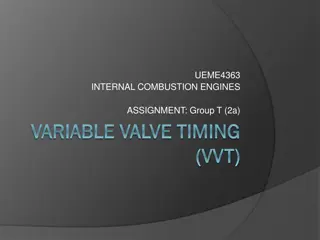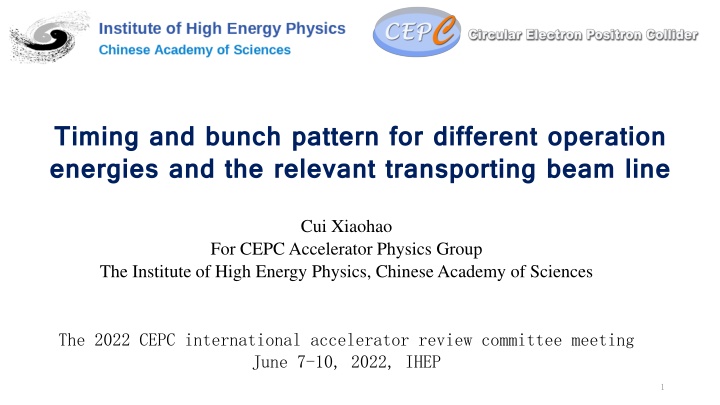
CEPC Accelerator Physics: Timing and Bunch Patterns for Operation Energies
Explore the timing and bunch patterns for different operation energies at the CEPC accelerator, revealing insights into beam transportation and line configurations. Learn about the injection and extraction processes, energy levels, and challenges faced during operation. Dive into the details of linac, damping ring, booster, and collider operations for various particle energies such as the Higgs, W, Z, and tt. Uncover the strategies for optimizing beam currents and ensuring efficient performance across the accelerator components.
Download Presentation

Please find below an Image/Link to download the presentation.
The content on the website is provided AS IS for your information and personal use only. It may not be sold, licensed, or shared on other websites without obtaining consent from the author. If you encounter any issues during the download, it is possible that the publisher has removed the file from their server.
You are allowed to download the files provided on this website for personal or commercial use, subject to the condition that they are used lawfully. All files are the property of their respective owners.
The content on the website is provided AS IS for your information and personal use only. It may not be sold, licensed, or shared on other websites without obtaining consent from the author.
E N D
Presentation Transcript
Timing and bunch pattern for different operation energies and the relevant transporting beam line Cui Xiaohao For CEPC Accelerator Physics Group The Institute of High Energy Physics, Chinese Academy of Sciences The 2022 CEPC international accelerator review committee meeting June 7-10, 2022, IHEP 1
Introduction Linac 20 GeV 20 GeV Gun Booster Ring Collider Ring 20 GeV 20 GeV Damping ring 1. Injection and extraction from: Linac, damping ring, booster, and collider; 2. Energy: Higgs (120 GeV), W (80 GeV), Z (45.5 GeV), tt (180 GeV); 2
Introduction Higgs W Z tt 11934 Bunch Number in collider 268 1297 35 23 ns Bunch Separation 591 ns 4524 ns 257 ns 3978 Bunch Number in booster 268 1297 35 1.33 0.92 0.3 0.33 Lifetime (hour) 146 Interval for top up* (s) 36 101 33 * Beam current in collider decays by 3%. Z-mode is the most challenging operation in terms of charge flux delivered by the injectors. At Z mode, the bunch number in the booster is only 1/3 of that in the collider, so the booster need to be ramped up and down 3 times to inject into every bunch in the collider. 3
1. Linac From the electron gun, bunches are generated in 100 Hz. pulse 10ms t For Z mode, more bunches are needed It can be upgraded to double bunch (100Hz, baseline choice) or 200 Hz. 4
2. Damping Ring Positron bunches will be injected into a damping ring at 1.1 GeV. Damping ring circumference Store time of the bunches: 150 m 20 ms T=0 T=10ms The bunches are injected into the damping ring with the same frequency as bunches in the Linac; For 200 Hz or double-bunch mode, more bunches will be stored in the damping ring; Each bunch which cooled for 20 ms will be extracted and re-injected into the linac. With small changes, the cooling time of the bunches can be increased by holding more bunches in the damping ring. T=20ms-250ns T=20 ms T=30ms-250ns 5
3. From Linac to Damping ring Damping ring circumference Store time of the bunches: Bunch number: 150 m 20 ms 4 (maybe 8) Energy: 1.1 GeV Beam: positron Linac repetition: 100Hz Double bunch mode needed for Z Before damping ring, Energy spread of the beam should be reduced in order to match the RF acceptance of the damping ring. After damping ring, Bunch of the beam should be reduced to control the energy spread after acceleration. 6
3. From Linac to Damping ring Chicanes for Bunch length control; Arcs for geometry design; Matching for injection twiss matching; Arcs Arcs Chicane Chicane Matching Matching 7
3. From Linac to Damping ring Lambertson Lambertson Kicker Kicker 0.5m 25mm Top View: Top View: 1.25m 1.25m 0.847m 1m 0.5m Side Side View: View: 8
4. Injection to booster tt 20 35 4.52 H 20 268 0.591 bunch by bunch 100 <1.29 <0.647 0.647 2.68 Energy GeV Bunch number Bunch seperation us Injection scheme bunch by bunch 100 <8.4 <4.2 4.2 0.35 Kicker frequency(Hz) Kicker pules duration (us) Kicker rise up/ fall down (us) Timing delay(us) Injection duration (s) To share the RF system, for tt and Higgs energy, bunches per beam are in the half ring both for booster and collider. 9
4. Injection to booster W 20 Energy GeV Bunch number Bunch seperation us Injection scheme Kicker frequency(Hz) Kicker pules duration (us) Kicker rise up/ fall down (us) Timing delay(us) Injection duration (s) 1297 0.257 bunch by bunch 100 <0.535 <0.2677 0.2677 12.9 For W mode, bunches are uniform in the whole ring both for booster and collider. 10
4. Injection to booster Z 20 78 Energy GeV Bunch number/train Bunch separation ns Number of trains Train separation (us) Kicker frequency(Hz) Injection scheme Kicker rise up/ fall down (ns) Flat top (ns) Injection duration (s) 23.076 51 5.11 200 or 100 (double bunch) bunch by bunch or two by two <23 ns 23.1 for double bunch mode 19.2 bunches per beam are distributed train by train both in booster and collider. (This will be talked about in detail later) The number of train in the booster is 1/3 of that in the collider. 11
4. Injection to booster Injection into the booster is a simple on-axis injection with 1 kicker Bunches from the Linac will be in 100 Hz or 200 Hz Booster Ring T TLinac Linac T Tbooster booster T TLinac Linac=N* =N*Turns+T Turns+Tbooster booster Changing TLinacslightly, we can fill the booster with any pattern we needed. 12
4. Injection to booster Twiss parameters for the transport line, and a top-view of the geometry 13
4. Injection to booster Injection into the booster is also a standard on-axis injection 14
5. Extraction from booster For Higgs, W, tt, the bunches are extracted bunch by bunch; For Z energy, the bunches are extracted train by train. Energy: 45 GeV, 80 GeV, 120 GeV, 180 GeV Beam: positron & electron Extraction for different bunch patterns. For Z energy, it becomes more complicated due to the large bunch number needed in the collider. the separation between bunches are only 20~30 ns. Considering the rise time of the kickers, bunches are arranged train by train in the collider for Z energy. 15
5. Extraction from booster tt Higgs W 180 37 4.2 120 240 0.647 80 Energy GeV Bunch number Bunch seperation us Extraction scheme Kicker frequency(Hz) Kicker pules duration (us) Kicker rise up/ fall down (us) Timing delay(us) Extraction duration (s) 1230 0.2677 bunch by bunch bunch by bunch bunch by bunch 1000 <8.4 <4.2 4.2 0.037 Z 1000 <1.29 <0.647 0.647 0.24 1000 <0.535 <0.2677 0.2677 1.23 45.5 80 23.076 48 5.11 train by train 1000 1.83 <12.05 <5.11 6.94 0.048 Energy GeV Bunch number/train Bunch separation ns Number of trains Train separation (us) Extraction scheme Kicker frequency(Hz) Flat top (us) Kicker pules duration (us) Kicker rise up/ fall down (us) Timing delay(us) Extraction duration (s) 16
6. Injection to Collider Energy: 45 GeV, 80 GeV, 120 GeV, 180 GeV Beam: positron & electron For tt, Higgs and W energy, injection into the collider is bunch by bunch; and for Z energy, injection is train by train. Considering the robustness of the design, the baseline injection of the main collider ring is conventional off-axis injection & an on-axis injection for Higgs. 17
6. Injection to Collider 1. Considering the robustness of the design, the injection of the main collider ring is conventional off-axis injection. (Maybe an on-axis injection is needed for Higgs) 2. For tt, Higgs and W energy, injection into the collider is bunch by bunch; and for Z energy, injection is train by train. Bunch by bunch Train by train Kicker: 1000 Hz 1000 Hz The kickers rise up, stay there to inject a whole train into the collider, and fall down. This process repeated in 1000 Hz, to inject all bunches into the ring. The kickers rise up, inject one bunch into the collider, and fall down. This process repeated in 1000 Hz, to inject all bunches into the ring. 18
6. Injection to Collider 66m 68m 60m 26m 19
7. A diagram of the time structure Extract from booster 0.035s Ramp up 7.3s Ramp down 7.3s tt 0.35s+7.3s+0.035s+7.3s ~15s Inject from Linac 0.35s Extract from booster 0.268s Ramp up 4.5s Ramp down 4.5s Higgs 2.68s+4.5s+0.268s+4.5s ~12s Inject from Linac 2.68s 20
7. A diagram of the time structure Extract from booster 1.29s Ramp up 2.7s Ramp down 2.7s W 12.9s+2.7s+1.29s+2.7s ~20s Inject from Linac 12.9s Extract from booster 0.048s Ramp up 1.6s Ramp down 1.6s Z Inject from Linac 19.9 (19.9s+1.6s+0.048s+1.6s)*3=69.5s 21
7. A diagram of the time structure On-axis injection 5s Ramp up 4.5s Ramp down 4.5s 2.4s+4.5s+5.0s+4.5s=16.4s Higgs on-axis Inject from Linac 2.4s tt Higgs (off-axis) Higgs (on-axis) W Z Interval for top up* (s) 33 36 36 101 146 Injection time for both e+/e-(s) 30 24 32.8 40 139 22
8. Injection from scratch Injection from scratch is easy for Higgs, W and tt. Yuan Zhang, Dou Wang Injection from scratch takes 10min for Higgs, and 16 mins for W. 23
8. Injection from scratch-Z Yuan Zhang, Dou Wang Design current in collider is 840mA. Total current in booster limited by RF system: < 10 mA (will be increased to 16mA) Collider lifetime: 19 hours (non-collision), 1.9~1.4 hours (w. collision)* Bootstrapping from 220mA Full injection from empty for both beam 2 hours (50min) Booster threshold: 10mA Booster threshold: 16mA *the beam lifetime with collision is related to the current. 24
9. From Collider to the Beam dump Beam dump put in one of the Beam dump put in one of the straight lines straight lines For machine and detector protection; Use one kicker and one septum to get the beams into the dump line, so all bunches can be dumped in one turn; Horizontal and vertical dilution kickers are used to change the position of different bunches at the dump, in order to reduce the beam damage to the dump. 25
9. From Collider to the Beam dump The Beam dump line and bunch distributions on the dump The Beam dump line and bunch distributions on the dump 26
Summary: 1. This talk gives a general overview of the timing of CEPC injection process and transport line design. 2. Some changes and optimization on the optics design have been made ; 3. Considerations on the bunch pattern for different energy, especially for Z energy mode; 4.Beam dump added as a part of the machine protection system. 27
Thank You! 28
Back Up:on axis injection 1. Inject 240 small bunches into the booster. 2. Ramp the booster to high energy and inject several bunches from the collider into the booster. 3. Booster stay at 120 GeV for 4 damping time(200ms), so that the injected large bunches merge with small bunches. 4. Inject the merged large bunches back to the same empty buckets left by the last step. 5. Repeat from last step. 29
Back Up:frequency f (MHz) CEPC SHB1 143 SHB2 572 Linac 2860 DR 650 booster 1300 collider 650 30

